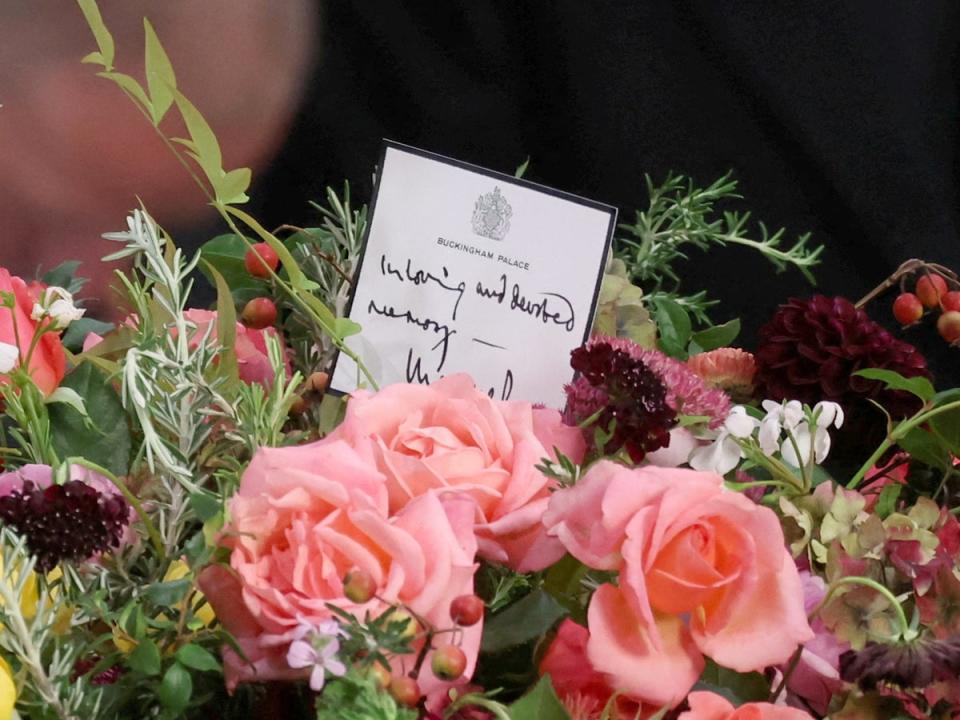From King’s handwritten note to palace flowers: Queen Elizabeth II’s state funeral explained
- Oops!Something went wrong.Please try again later.
- Oops!Something went wrong.Please try again later.
- Oops!Something went wrong.Please try again later.
The life of Britain’s longest-serving monarch, Queen Elizabeth II, has been celebrated at a majestic funeral ceremony at Westminster Abbey.
The Queen’s coffin was draped with the Royal Standard and carried a wreath that contained myrtle from the same plant she carried in her wedding bouquet.
Among the flowers was a simple card from her son, King Charles III, reading: “In loving and devoted memory, Charles R.”

More than 100 heads of state and government from around the world were among the more than 2,000 members of the congregation dressed in black and military attire.
Among them too were members of the royal family, there to say goodbye not only to a monarch but to someone close to their heart and the head of their family.
Here, The Independent unpacks the ceremony and some of the unique traditions in the final goodbye to Her Majesty.
The procession
Royal Navy sailors pulled the two-and-a-half tonne State Ceremonial Gun Carriage bearing the Queen’s Coffin from Westminster Hall to Westminster Abbey. Others marched behind the carriage acting as brakes.
This has been a tradition since the State Funeral of Queen Victoria in 1901. Before that, the service was pulled by horses, but the cold of that day led the animals to rear up and Captain Prince Louis of Battenberg was concerned for the safety of the coffin.
Prince Louis consequently approached Edward VII, the new king, and suggested that his men step in to avoid further complications. That way a tradition was born.
The Sovereign’s Guard has since hauled the carriages of former monarchs and other distinguished figures in British history with a white rope. Ninety-eight of them performed the duty on Monday, followed by another 40 in place behind to act as a brake.
The carriage is a field gun carriage that has been in the care of the Royal Navy since 1901, when it was removed from active service for Queen Victoria’s funeral. It was previously used for the funerals of King Edward VII, King George V, King George VI, Winston Churchill and Lord Louis Mountbatten.
The coffin
Draped in the Royal Standard, upon the Queen’s coffin also lie the Instruments of State - the Imperial State Crown on a velvet cushion, the Orb and the Sceptre.
The golden orb, surmounted by a cross, symbolises Christianity, and the sceptre is a symbol of fairness and justice.
At the King’s request, the wreath on top of the coffin contains rosemary, English oak and myrtle cut from a plant grown from myrtle in the Queen’s wedding bouquet.
It also contains flowers in shades of gold, pink and deep burgundy, with touches of white, cut from the gardens of royal residences, Buckingham Palace, Clarence House and Highgrove House.
Rosemary symbolises remembrance, myrtle is the ancient symbol of a happy marriage and English Oak symbolises the strength of love.
The Service
Before the service, the tenor bell was tolled every minute for 96 minutes, marking the years of Queen Elizabeth II’s life.
The Archbishop of Canterbury, Justin Welby, gave the sermon on Monday.
“Her late Majesty famously declared on her 21st birthday broadcast that her whole life would be dedicated to serving the nation and commonwealth, rarely has such a promise been so well kept,” he told the congregation. “Few leaders receive the outpouring of love that we have seen.”
The Very Reverend Dr David Hoyle MBE, Dean of Westminster, gave the bidding, while the Baroness Scotland of Asthal KC, Secretary-General of the Commonwealth, read the first lesson and Prime Minister Liz Truss read the second.
Members of foreign royal families, heads of state, and overseas government representatives were received at the Great West Door by the Dean and Chapter of Westminster and were conducted to their seats in the Lantern.
The vergers taking part in the funeral represented the Churches of Wales, Scotland, Northern Ireland and England.
Music
During the service, the State Trumpeters of the Household Cavalry sounded the Cavalry Last Post before the nation fell silent in remembrance of the Queen.
Westminster Abbey said on Monday that much of the music at the funeral was selected for its “special significance” to the Queen, and many of the choices have a long association with Westminster Abbey.
The hymns were sung by the choir of Westminster Abbey and the choir of the Chapel Royal, St James’ Palace. They included ‘The Lord’s My Shepherd’ and ‘Love Divine, all Loves Excelling.’
The State Trumpeters of the Household Cavalry were led by Trumpet Major Julian Sandford. The Fanfare Team of the Household Division Bands was conducted by Lieutenant Colonel David Barringer MBE, Commanding Officer, Household Division Bands.
The organ was played by Peter Holder, Sub-Organist, Westminster Abbey.

